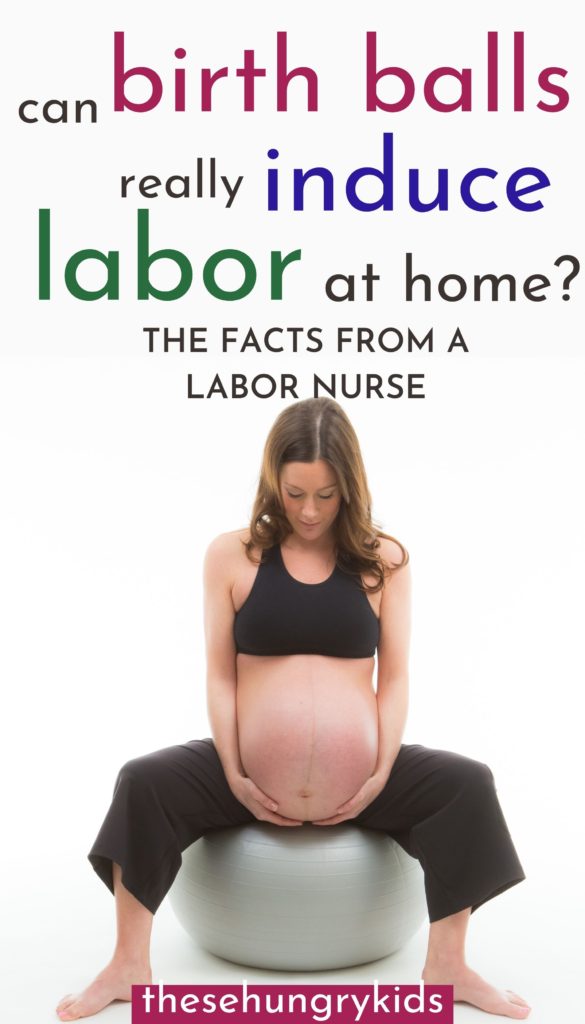Everyone wants to know: does bouncing on a ball induce labor? Birthing balls can do many things, but kick-starting labor may not be one of them.
The end of pregnancy is uncomfortable. Many moms desperately try to find ways to induce labor naturally at home, whether to avoid a medical labor induction or to just be done with the pregnancy.
One of the most commonly heard of ways to induce labor at home is by sitting on a birthing ball or exercise ball. But does it actually work?
As with most things in life: if it seems too good to be true, it probably is. Using an exercise ball to induce labor is not as simple as it seems.
As a labor nurse, I can’t tell you how often women ask if they can sit on a ball to start labor. I totally understand why many moms are ready to be done with their pregnancy and meet their little babe, but unfortunately it’s not that easy. Birthing balls and exercise balls can help with many aspects of labor, but they won’t necessarily start labor.
Keep reading to see what I mean.

This post contains affiliate links for your convenience. That means if a purchase is made using the links from this post, I may earn a small commission at no additional cost to you. This helps keep my site running and I thank you for supporting my small business!
Can bouncing on a birthing ball or exercise ball induce labor?
There are many benefits to using birthing balls or exercise balls during pregnancy and labor. But bouncing on a birthing ball is does not induce labor.
However, bouncing on a ball does have its benefits. These include keeping the muscles and ligaments of the pelvis open and relaxed, as well as helping baby move lower towards the birth canal.
Softly bouncing on a birthing ball may help the baby move lower in the pelvis, which can apply some pressure to the cervix. Having the baby engaged in the pelvis can help speed up labor when the time comes. Using birthing balls during the later stages of pregnancy is a great idea to help prepare your body for childbirth.
If your body is ready for labor, sitting on a birthing ball or exercise ball could help get things started. You can try getting labor to start by gently bouncing, doing a figure 8 with your hips, and rocking them back and forth. But if your body is not ready for labor, there is really nothing you can do to start it.

How long should you bounce on the ball?
There is no minimum or maximum time for you to bounce on a birthing ball. You can do it as long as you are comfortable.
That being said, changing positions is very helpful to helping labor move along and maintaining proper body alignment. I recommend spending 20-30 minutes on the ball, then changing positions for another 20-30 minutes, and repeat.
When should you start bouncing on a birthing ball?
You can use a birth ball at any point in the pregnancy. You don’t have to just bounce – sitting on a ball, gently bouncing, swaying your hips, and rocking back and forth can help alleviate some of the third trimester discomforts.
Using birthing balls or exercise balls throughout pregnancy can help alleviate back pain and will help keep the muscles and ligaments in the pelvis loose and ready for labor.
I started sitting on a ball in the late-second trimester and early-third trimester to alleviate lower back and hip pain. I would often watch TV or eat dinner while gently rocking side to side on the birthing ball.
By the middle of the third trimester, it may be a good idea to spend a little time on the birthing ball every day. Gently bouncing on the birthing ball may help the baby descend lower into the pelvis towards the birth canal.

Difference between yoga ball or exercise ball and a birthing ball
Yoga balls and exercise balls are very similar to birthing balls.
Birthing balls tend to be larger and firmer than a yoga or exercise ball. This offers additional support so you don’t feel like you’re sinking down too low when sitting on the ball. Birth balls are designed to support the extra weight of a pregnant woman and are made of a thicker material.
For safety reasons, I recommend getting a birth ball versus an exercise or yoga ball. The extra height and firmness is much safer and will help prevent you from falling or sliding. Additionally, many birth balls have an anti-slip finish.
You can always use the birthing ball for exercise or yoga afterwards, but during pregnancy and labor it’s better to have the extra support.
Related: Can prenatal massage induce labor?
Best birthing ball brand
I personally recommend The Birth Ball brand. I’ve talked about this product a few times on this blog.
Their balls come with anti-skid socks, a booklet of exercises for during and after pregnancy, and a hand pump so you can inflate the ball as firm or soft as you’d like.
The Birth Ball’s birthing balls are also made of a thicker material than most, so they are very durable. I believe they have a superior product to most. The ball should last through several pregnancies!

Best birthing ball alternative
If you would rather get an exercise ball, I recommend this one. The reason I would recommend this one over others is because it has similar features to The Birth Ball. It is anti-slip, burst-resistant, and comes in different sizes (you’ll want a larger one for more support.

Using a birthing ball during labor
Birthing balls are one of my favorite labor tools!
Not only is it a great way to alleviate pain in labor, it also may help make labor faster.
There are several ways to use a ball during labor. Here are some of my favorite birthing ball exercises:
- Sit on a birth ball and gently move hips during or between contractions. This can help the baby’s head move lower and apply pressure to the cervix. It is also good for pain relief and is a gentle distraction. You can also ask your partner to rub your back or provide extra support from behind.
- On your hands and knees, lean over the birth ball for support. This position in particular may help with back labor.
- Lean against the wall with the birth ball. You can either face the wall, or put your back to it with the ball between you and the wall.
If you haven’t started using your birthing ball yet, what are you waiting for? Even if birthing balls don’t induce labor, they can definitely help!

The form you have selected does not exist.

